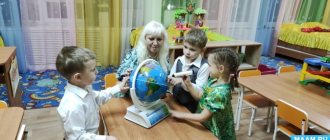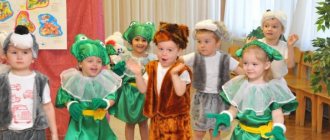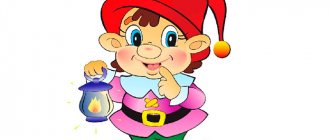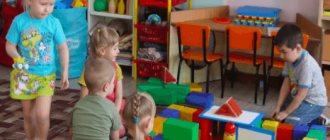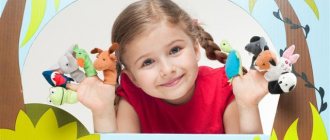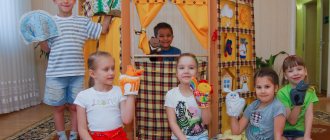Preparatory group. Senior preschool age. Children 6-7 years old
Lesson summary for senior preschool children “Staging an excerpt from Bolit Chukovsky "Aibolit"
Goal: To ensure that children remember knowledge about the elements of the road (roadway, pedestrian crossing, sidewalk, about the rules of movement on the side of the road; to consolidate knowledge about familiar traffic rules. Material:...
Scenario of a puppet show for children 5–7 years old “The Tale of a Virus”
Scenario of the event for children 5-7 years old “The Tale of the Virus”
Description: A fairy tale for children of senior preschool age is aimed at overcoming the feeling of fear of a new viral infection. Purpose: The fairy tale is intended for children of senior preschool age, for teachers...
Dramatization of a Russian folk tale in the preparatory group
Dramatization of the Russian folk tale “Zayushkina’s Hut.” Preparatory group

Goal: To teach how to dramatize the Russian folk tale “Zayushkina’s Hut.” Creating conditions for the child to develop an interest in theatrical activities and a desire to perform with a group of peers. Introduce the basics of acting. Learn to portray the emotional state of a character using expressive movements and intonation. Introduce tempo and rhythm. Learn clearly, pronounce words and sentences with different intonations (question, request, surprise, sadness, fear, etc.). Develop plastic movement, speech, logical thinking, imagination. Cultivate interest in theatrical activities. Objectives : To arouse interest in theatrical and play activities, to create a sense of success for each individual child; continue to introduce theatrical terminology (actor, director), drama theater to improve the ability to tell a fairy tale by role; teach intonation to convey the mood of the hero; cultivate a sense of empathy, sympathy; introduce “fairytale” vocabulary into children’s active vocabulary (bast, carrying a scythe, sitting on the stove). Material: Model of ice and bast huts, child-sized trees, bushes;
costumes (fox, hare, rooster, bear, dog, wolf); stump, sun, cloud. Progress of the dramatization game
Host: Dear guests! Watch and listen to the fairy tale “Zayushkina’s Hut.” Once upon a time there lived a Fox and a Hare. The Fox had an ice hut, and the Hare had a bast hut. The beauty of spring has arrived. Under the warm rays of the spring sun, the Fox's hut has melted, and the Hare's hut stands as if nothing had happened. So the Fox ran to the neighbor Fox: Bunny neighbor, let me warm up. Let me go, dear! Hare: Come in, Fox. Presenter: Before the Fox had time to enter the hut, she immediately began to chase the poor Hare. Fox: Go away, Oblique! So that your spirit is gone! Presenter: The Fox chased the Hare. He sat down on a tree stump and cried. Walks past the Dog: “Aw-aw-aw! What are you crying about, Hare? Hare: How can I not cry? I had a bast hut, and the fox had an ice hut. Spring has come, her hut has melted. She asked me to warm up and kicked me out. Dog: Don't cry, Hare. I'll kick her out! Presenter: The Dog went to the hut and began to chase the Fox. Dog. Aw-aw-aw! Go away, Fox. Aw-aw-aw! Fox: As soon as I jump out, as soon as I jump out, scraps will go down the back streets! Presenter: The Dog got scared and ran away into the forest. And the Hare still sits on the stump and cries. A wolf walks past. Wolf:What are you crying about, Hare? Hare: How can I not cry? I had a bast hut, and the fox had an ice hut. Spring came, her hut melted - she asked me to warm up and kicked me out. Wolf: Don't cry, Zainka. I'll kick her out! Hare: No, you won’t kick me out. The dog chased him, but he didn’t drive him out, and you, Wolf, won’t drive him out. Wolf: No, I'll kick you out! Presenter: The Wolf approached the hut and began to chase the Fox. Wolf: Come on, Fox, get out! Presenter: And Fox Wolf was a little scared. Fox: As soon as I jump out, as soon as I jump, scraps will go down the back streets. Presenter: The Wolf got scared and... ran away. Bear walks past the Hare. Bear: What are you crying about, Hare? Hare: How can I not cry? I had a bast hut, and Lisa had an ice hut. Spring came, and the Fox’s hut melted. She asked me to warm up and kicked me out. Bear: Don't cry, Bunny, I'll kick her out! Hare: No, Bear, you won’t kick him out. The dog chased but didn’t drive him out, the Wolf chased him but didn’t drive him out, and you, Bear, won’t drive him out. Bear: No, you-go-nu! Presenter: The Bear approached the hut and began to chase the Fox. Bear: Get out, Fox! Immediately! Host: But Lisa was not afraid. Fox: As soon as I jump out, as soon as I jump, scraps will go down the back streets. Presenter: The Bear got scared and ran away. The Rooster walks past the Hare. Rooster: Ku-ka-re-ku! Why are you crying, Bunny? Hare: How can I not cry? I had a bast hut, and Lisa had an ice hut. Spring came, and the Fox’s hut melted. She asked me to warm up and kicked me out. Rooster: I'll kick her out now! Hare: No. You won't kick me out. The dog chased but didn’t drive him out, the Wolf chased but didn’t drive him out. The bear drove him away, but he didn’t drive him out, and you, Cockerel, won’t drive him out. Rooster: No, I'll kick you out! I am a brave Rooster! Ku-ka-re-ku! Presenter: The Rooster approached the hut and began to chase the Fox. Rooster: Ku-ka-re-ku! I carry the scythe on my shoulders, I want to whip the Fox! Get out, Lisa. Fox: I’m putting on a fur coat... Rooster: Ku-ka-re-ku! I carry the scythe on my shoulders, I want to whip the Fox! Go, Fox Leader: The fox got scared and ran away. And the Hare and the Rooster began to live in Zaika’s hut. That's the end of the fairy tale!
We recommend watching:
Master Class. DIY shadow theater
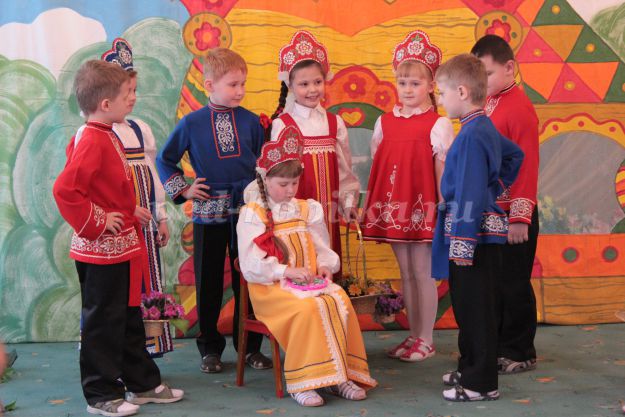
Photo report from the fairy tale “The Scarlet Flower” Synopsis of a theatrical lesson in the second junior group Synopsis of a joint theatrical activity in a preparatory group on Russian folk tales
Similar articles:
The fairy tale “At the behest of the pike” in a new way. Role-based script for older preschoolers
Card index of fairy tales for dramatization in preschool educational institutions
art therapy specialist
for dramatization of fairy tales
for preschool children.
in the senior group of kindergarten
(Runs to the music, stops at the Hare’s house. He knocks. The Hare opens the door.)
I invite you to the wonderful world of children's theater. ROLES FOR THE TALE:
Characters:
•
Tooth Fairy • Dragon • Hare • Bear • Small Bird
Scenery: summer forest, forest river.
PROGRESS OF A FAIRY-TALE PERFORMANCE.
Card index of theatrical games in the preparatory group
Lyubov Komogortseva
Card file of theatrical games in the preparatory group
Authors: Komogortseva L. A., Gorbunova I. V.
(Theater on the hand – finger) Game “The Tale of the Little Goat Who Could Count to 10.” (V. Suteev)
Tasks for the teacher: To promote the development of creative independence, aesthetic taste in conveying the image.
Game task for children: Mastering counting skills through dramatization of a fairy tale
Attributes: Finger-sewn fairy tale characters (kid, calf, cow, bull, horse, pig, rooster, ram, cat, dog); boat; clearing, trees.
Preliminary work: Getting to know the content of the fairy tale, looking at the illustrations, learning the words of the fairy tale characters.
Game rules: 11 children play (heroes and presenter). Children independently assign roles and determine the order in which the characters perform
Game actions: The action begins in the clearing. The kid counts first the calf, then the cow, and so on in turn the horse, pig, and ram. Everyone runs after the kid to the river where the boat is located. But to sail on a ship you can have 10 animals. The little goat counts all the animals on the shore and on the ship. Everyone boards the ship, concluding that it is useful to be able to count.
Result: Dramatization of a fairy tale.
(Theater on the hand - finger)
Game “Puss in Boots” (C. Perrault)
Tasks for the teacher: Develop clear pronunciation, consistency of character dialogue.
Game task for children: Develop the ability to coordinate actions with other children.
Attributes: Finger-sewn fairy tale characters: Cat, cat owner, king, princess, ogre, mouse. Illustrations – scenery with a river, field, carriage, cannibal palace
Preliminary work: Reading the fairy tale “Puss in Boots” by C. Perrault, watching the cartoon “Puss in Boots”, learning the words of the characters. Drawing scenery of a river, field, carriage, ogre's palace.
Game rules: 6 children play - heroes, 1 - presenter.
Game actions: The game begins with the younger brother inheriting a cat. The cat takes the bag, puts on his boots and goes hunting. From the hunt he brings gifts to the king from his master, the Marquise de Carabas. Then, on the river, the cat deceives the king that his owner is drowning. The king's servants save him. The king, along with the marquis and the princess, go to the ogre's palace. The cat runs in front of the carriage and warns that they say that all the possessions of the Marquis de Carabas. In the castle he deceives the cannibal. He turns into a mouse and the cat eats him. In the castle, the king marries his daughter, the princess, to the Marquis de Carabas.
Result: Dramatization of a fairy tale.
(Theater on the hand - mittens) Game "Snow Bun". (A fairy tale in a new way)
Tasks for the teacher: Teach children to act expressively in accordance with musical accompaniment
Game task for children: Expand vocabulary and develop memory.
Attributes: Fairy tale characters sewn from mittens (snow bun, fox, hare, wolf, bear, cat, girl Masha; scenery: forest clearings.
Preliminary work: Familiarization with the content of the fairy tale, learning the words of the fairy tale characters. Drawing the scenery of forest clearings.
Game rules: 7 children - heroes and 1 child - leader; Children determine the order in which the heroes speak on their own. The teacher selects musical accompaniment.
Game actions: The action begins with the meeting of the bun and the fox. Next, the snow bun meets a hare, a bear, a wolf, and a cat. From the last time the bun meets the girl Masha, who brings peace to all the animals.
Result: Staging a fairy tale with the help of a teacher
(Theater on the hand - mitten)
Game “The Ugly Duckling” (H. H. Andersen)
Tasks for the teacher: To develop the experience of social skills through theatrical activities
Game task for children: Develop dialogic and monologue speech.
Attributes: A duck sewn from a mitten, two ducklings, an ugly duckling (a small swan, a swan, scenery with a pond, ducks, a hunter's house.
Preliminary work: Reading the fairy tale by H. H. Andersen “The Ugly Duckling”, learning the words of the characters and individual episodes
Game rules: 4 children and 2 presenters play.
Game actions: The game begins: the duck sits in the nest on the eggs. Next, the ducklings hatch from the egg. And from one a duckling emerges, unlike the others. Everyone on the pond laughs at him and calls him an ugly duckling. In the fall, everyone flies south, but he stays. A hunter rescues him and takes him for the winter. And in the spring, the ugly duckling turns into a beautiful swan. His mother duck and brother and sister do not recognize him.
Result: Fairy tale dramatization
(Theater on the hand - glove) Game "Little Red Riding Hood". (C. Pierrot)
Tasks for the teacher: Develop the ability to analyze the actions of fairy-tale characters.
Game task for children: Improve imaginative performing skills
Attributes: Fairy tale characters sewn from gloves (Little Red Riding Hood, wolf, grandmother, Little Red Riding Hood’s mother, 2 hunters); scenery of the forest and grandmother's house.
Preliminary work: Examination of illustrations, learning the words of fairy tale characters, drawing forest clearings.
Game rules: 7 children play. Children independently determine the order of performance of the heroes, the presenter changes the scenery.
Game actions: The game starts near the house. Mom sends Little Red Riding Hood to her grandmother with pies. A girl meets a wolf in the forest. The wolf sends Little Red Riding Hood along the long road, and he goes to his grandmother along the short road. The wolf comes to the grandmother, swallows the grandmother, puts on her clothes and lies down under the blanket on the bed. Little Red Riding Hood did not recognize the wolf in her grandmother. The wolf ate the girl too. Hunters walked by, they ripped open the wolf's belly and freed the grandmother and Little Red Riding Hood.
Result: Dramatization of a fairy tale.
(Theater on the hand - glove)
Game “Silver Hoof” (P. Bazhov)
Tasks for the teacher: Teach children to look for expressive means to create the image of their hero.
Game task for children: Development of figurative memory and speech. Reinforcing the concepts of on, behind, above, in front.
Attributes: Girl Darenka, grandfather Kokovanya, cat, goat Silver Hoof, sewn from gloves.
Preliminary work: Reading P. Bazhov’s fairy tale “The Silver Hoof”, learning the words of the characters and the author. Drawing the scenery of the forest with the Silver Hoof, the forest and the houses.
Game rules: 5 children play, the teacher helps with organization.
Game actions: The game begins in the village. The girl Darenka meets her grandfather Kokovanya. They go into the forest. Grandfather hunts, Darenka cleans the house. One day Kokovanya went out to buy groceries, and Darenka and the cat stayed at home. At night, a goat was jumping near the house, and precious stones were flying from under its hooves. In the morning, he and his grandfather looked for precious stones. Silver Hoof came several more times.
Result: Dramatization of a fairy tale.
(Theater on the hand - shadow theater)
Game “Fear Has Big Eyes”
Tasks for the teacher: Develop creative independence in conveying an image
Game task for children: Develop skills in independent organization of theatrical activities
Attributes: Made from black paper: grandmother, granddaughter, chicken, mouse, hare, bench, stove, apple, apple tree.
Preliminary work: Watching the cartoon. Conversation based on the plot of a fairy tale. Learning the words of the characters and the words of the author.
Game rules: 7 children play (5 heroes, author and decorator). The decorator helps with the decorations.
Game actions: The game begins with the grandmother, granddaughter, chicken, and mouse going to get water. They walked back through the garden, and there was an apple tree growing there. A hare was sitting under an apple tree. The wind blew and one apple fell on the hare's forehead. He got scared and rolled under the feet of the water carriers. They also got scared, threw the buckets and ran home. The grandmother thought that a bear had attacked her. The granddaughter thought that a terrible wolf had attacked her; the chicken is a fox, the mouse is a mustachioed cat. The hare thought that 4 hunters were rushing after him, all with dogs. Conclusion: fear has big eyes.
Result: Dramatization of a fairy tale.
A card index of low-intensity outdoor games with speech content for children in the preschool group. I bring to your attention the first part of a card index of outdoor games with speech content. Card index of outdoor games with speech content for.
Card index of outdoor games of medium intensity with speech content for children of the preparatory group for school Card index of outdoor games with speech content for children of the preparatory group for school. Medium intensity outdoor games1. “STREEKS.
A card index of high-intensity outdoor games with speech content for a preparatory school group. A card index of outdoor games with speech content for a preparatory school group. High intensity outdoor games 1. “FROST – RED.
Card index of role-playing games in the preparatory group September Polyclinic. Target. Continue to familiarize children with the activities of medical personnel. Develop the ability to creatively develop a plot.
Card file of motivation options for conducting educational activities in visual arts in the preparatory group Lexical topic Lesson topic Motivation Tools “Children clearing the area of snow” (wax crayons) Game: “Who are these tools for?”
Notes of theatrical games and activities Study of “goat-trouble” (finger theater) (N.F. Sorokina, L.G. Milanovich, p. 40) To carry out this game you will need a finger puppet -.
Consultation for parents “The role of theatrical games in the development of a child” In modern society, the social prestige of intelligence and scientific knowledge has sharply increased. Connected with this is the desire to give children knowledge and teach.
Emotional development of a child through theatrical games A truly integral person can be called one whose emotional and intellectual principles are equally developed. Teachers.
Source
Literary leisure “Connoisseurs of fairy tales” in the preparatory group
Goals:
1. Be able to distinguish fairy tales, know their features and authors. Be able to recognize a fairy tale from an excerpt, know the fairy tales of different peoples.
2. Develop the ability to use knowledge of fairy tales in a new situation, develop thinking, imagination, memory, speed of reaction, explanatory speech, attention.
3. Cultivate interest in fairy tales, foster good feelings towards elders, and cultivate moral qualities.
Methods and techniques.
Questions, conversation, looking at illustrations, a surprise moment. Find out the fairy tales from the passage. Answer the question quickly. Guess the melody for the fairy tale.
Preliminary work.
Reading fairy tales, looking at illustrations, conversations on the content of fairy tales, exhibition of books “Fairy Tales”. Acquaintance with the works of Russian and foreign writers. Getting to know fairy tales of different nations, watching cartoons based on fairy tales, listening to songs from cartoons.
Leisure progress.
- Guys, look, a magic tree has grown in our group. Let's come and take a look at it.
-What do you see on this tree? (Illustrations for fairy tales.)
- What fairy tale is this illustration for? ("Puss in Boots".)
-Who is the main character of this fairy tale? (Cat, Marquis.)
—Who is the author of this fairy tale? (Charles Perrault.)
- What country did he live in? (In France.)
— Guys, look carefully, there are also illustrations for fairy tales by Charles Perrault.
- Name these fairy tales. (“Cinderella”, “Little Red Riding Hood”.)
- And what fairy tale are these illustrations for (“The Frog Princess”, “Sivka Burka”.)
-Who is the author of these fairy tales? (Russian people.)
— Guys, are there any more fairy tales left here? (Yes.)
What kind of fairy tales are they for? (“Thumbelina”, “The Ugly Duckling”.)
- Who is the author of these fairy tales? (H. H. Andersen.)
- Well done. This was not a big warm-up for you and me. and now we will test your knowledge of fairy tales.
We need to split into two teams.
The first team is “Vasilisa the Wise”, and the second team will be called “Seven Bogatyrs”
First I will ask questions to the first team, for each correct answer the team receives one point. If the first team finds it difficult to answer, they can get help from the second team, thereby earning points for themselves.
Questions for the first team.
1. What did the needlewoman drop into the well? (Spindle.)
2. Where did the genie live for 1000 years? (Lamp.)
3. What musical instrument did the swineherd have? (Flute.)
4. Author of the fairy tale “Little Red Riding Hood”? (Charles Perrault.)
5. What were the names of the three little pigs in one fairy tale? (Nif-nif, Naf-naf, Nuf-nuf.)
6. Author of the fairy tale “The Ugly Duckling”? (H. H. Andersen.)
7. What did the month of April give to your stepdaughter? (ring.)
8. What is the name of the girl with blue eyes? (Malvina.)
9. Name Snow White’s little friends? (Gnomes.)
10. Name a Ukrainian fairy tale with similar content to a Russian folk tale? (Teremok, Mitten.)
11. How many meetings did the old man and the fish have? (6.)
12. Which flower did the monster love most? (The Scarlet Flower.)
13. How did the hare boast in one fairy tale? (I don’t have a mustache, but whiskers; not paws, but paws.)
Summarizing.
Questions for the second team.
1. Who destroyed the tower? (Bear.)
2. What kind of transport did Emelya like to ride? (On the stove.)
3. Where should a bear not sit? (On a stump.)
4. Author of the fairy tale “The Silver Hoof”? (P. Bazhov.)
5. What were the names of the little mice in the Ukrainian fairy tale “Spikelet”? (Twist and Turn.)
6. Author of the fairy tale “The Little Humpbacked Horse”? (Ershov.)
7. Name a Russian and German fairy tale with a similar plot about how the weaker one overtook the strong and boastful one in a duel? (Russian – “The Fox and the Crayfish”; German – Brothers Grim “The Hare and the Hedgehog”.)
8. What caused the destruction of the “Cat House”? (Fire.)
9. Who wore size 45 boots? ("Uncle Styopa")
10. Where did Pinocchio stick his nose? (Into the hearth)
11. Which fairy tale contains a warning that you should not drink raw water? (“Sister Alyonushka and brother Ivanushka.”)
12. About which princess did they say that she was traveling in a box? ("Princess Frog".)
13. Name a fairy tale in which one hero threatens another “When I jump out, when I jump out”? (“Zayushkina’s hut.”)
Summarizing.
Second competition “Find out a fairy tale from an excerpt”
Assignment to the first team.
1. From which work are these lines: Suddenly, from somewhere a jackal on a mare galloped up, here is a telegram from a hippopotamus. (“Aibolit”) name the author? (K. Chukovsky.)
2. Grandma, grandma, why do you have such long arms? (“Little Red Riding Hood”) name the author? (Charles Perrault.)
3. Get into one ear of mine and out the other - everything will work out. (“Kroshechka – Khavroshechka”) who wrote this fairy tale? (This is a Russian folk tale.)
4. He will shop with grief across the floors, turn to the mirrors - all the partner’s work is coming apart at the seams. (“Uncle Styopa”) name the author? (S. Mikhalkov.)
5. Wind, you are a powerful wind, you drive flocks of clouds, you stir the blue sea, you blow everywhere in the open air. (“The Tale of the Sleeping Princess and the Seven Knights”), name the author? (A.S. Pushkin.)
Task for the second team.
1. From which work are these lines taken: Month, month, my friend, gilded horn. you stand up in the deep darkness, chubby, bright-eyed. (The Tale of the Sleeping Princess and the Seven Knights) - who is the author of this tale? (A.S. Pushkin.)
2. A woman planted a magic seed in a pot, and a beautiful large flower grew, inside of which sat a tiny girl (Thumbelina), the author of the fairy tale? (H. H. Andersen)
3. A heavy stone pulls to the bottom, a fierce snake sucked out the heart (“Sister Alyonushka and Brother Ivanushka”). Name the author of this fairy tale? (This is a Russian folk tale.)
4. And the dishes go forward and forward through the fields through the swamps (“Fedorino’s grief”), name the author? (K. Chukovsky)
5. The wind blows across the sea and propels the boat, it runs in the waves on swollen sails. (“The Tale of Tsar Saltan”) the author of this tale? (A.S. Pushkin.)
The next competition of our evening is “Musical”
You will need to guess the melody from familiar cartoons.
Listen to the first musical excerpt
1. Cartoon “The Town Musicians of Bremen”
(There is nothing better in the world than wandering around the world with friends...)
2. Song of hedgehog grandmothers from the cartoon “The Flying Ship”
(Stretch the bellows of the accordion, sing, play, play...)
3. Song from the cartoon “Holidays in Prostokvashino”
(If it weren’t for winter in cities and villages, we would never have known these happy days...)
4. The merman’s song from the cartoon “The Flying Ship”
(I’m a merman, I’m a merman, someone would talk to me, otherwise my friends are leeches and frogs...)
5. Song from the cartoon “Little Raccoon”
(A smile makes a gloomy day brighter, a smile makes a rainbow light up in the sky...)
6. Song of the Bremen Town Musicians (Well, let’s all open our ears together, it’s better to clap your hands well...)
7. Lullaby from the cartoon “Umka”
(Your neighbors the polar bears are sleeping, sleep and you will soon be a baby...)
8. Song of the robbers from the cartoon “The Town of Bremen”
(Give me some cards to tell your fortune about the king, oh la-la oh la-la....)
Summarizing.
- Well done guys, today you have pleased me with your knowledge, and there are still a lot of interesting and exciting things ahead of us.
Author-
Author: Maybe it’s true, maybe it’s not, It was recently, but maybe it wasn’t. Once upon a time there lived a beautiful girl and her name was Mashenka. And that's what happened to her one day.
Masha: (Screaming, crying) I don’t want to wash my hands, I don’t want to eat, I’ll whine all day, I won’t listen to anyone!
Author. Her beloved dog Barbos came running.
Barbos: What happened to our Masha? She cries, screams, doesn't want to do anything!
Author. The beloved kitten sits next to Masha
Murzik: Let's talk, console!
Barbos: Mashenka, let's go for a walk.
Murzik: Look how nice the weather is...
Masha: I want a bad one, let it rain!
Murzik: But then you'll get wet!
Masha: I want to get wet!
Murzik: Maybe you're hungry? I'll bring you...
Masha: I don’t want anything!
Barbos: And would you like some ice cream? Creamy, chocolate, strawberry, lingonberry...
Masha: No ice cream, no cake!
Murzik: maybe you're thirsty? Would you like me to bring you some tea?
Masha: I don’t want anything! No ice cream, no cake, no tea, no milk, no cocoa!
Murzik and Barbos together: Why are you crying and screaming then?
Masha: Why do I keep screaming? What do you care, I don’t want anything! I'm tired of everything!
Barbos: Maybe you're sick? Let's call a doctor for you.
Murzik and Barbos together: Doctor, doctor, our Masha is sick.
Enter the Lamb and the Cockerel.
Murzik and Barbos together: Our Masha is sick! And we don’t know what!
Lamb: Say Masha: “a-a-a”!!
Masha: Be-e-e-e
Lamb: Breathe
Masha: Breathe yourself!
Cockerel: AHA! WOW!
Masha: (Stops crying) What’s “aha” and what’s “wow”?! What are you saying?
Lamb: Okay, I'll tell you a secret! Just don't tell anyone!
Masha: I won’t tell anyone, but what?
Lamb: YOU swallowed Capriciousness. It flew and flew into your mouth when you were crying.
Masha: Did I swallow Kaprizka? What is he like?
Cockerel: He is an angry, unwashed, terrible beast, a bug, a vicious one, loves boredom, he has gotten into you now!
Lamb: Here he is, right next to him, close, And he’s called Capricious!
Cockerel: He flew and flew into your mouth when you were crying, and you yourself became a whimsy!
Masha: (crying) I don’t want to be Capricious! Lamb: Then say cheerfully and loudly, “I don’t want to be Capricious, Capricious, get out!”
Masha: “I don’t want to be Capricious and I won’t cry anymore, Capricious, get out!”
Masha, Murzik, Barbos : Eliminated! Flew out! There he flew! Capricious!
Murzik, Barbos: Thank you, doctor, you cured our Masha!
Masha: Where did Kaprizka fly?
Murzik: Look for guys who cry and are capricious. It will fly into their mouth and they themselves will become whims!
Masha: I won’t cry or open my mouth anymore!
Author: So Masha managed to defeat Kaprizka and become a good, obedient girl!
